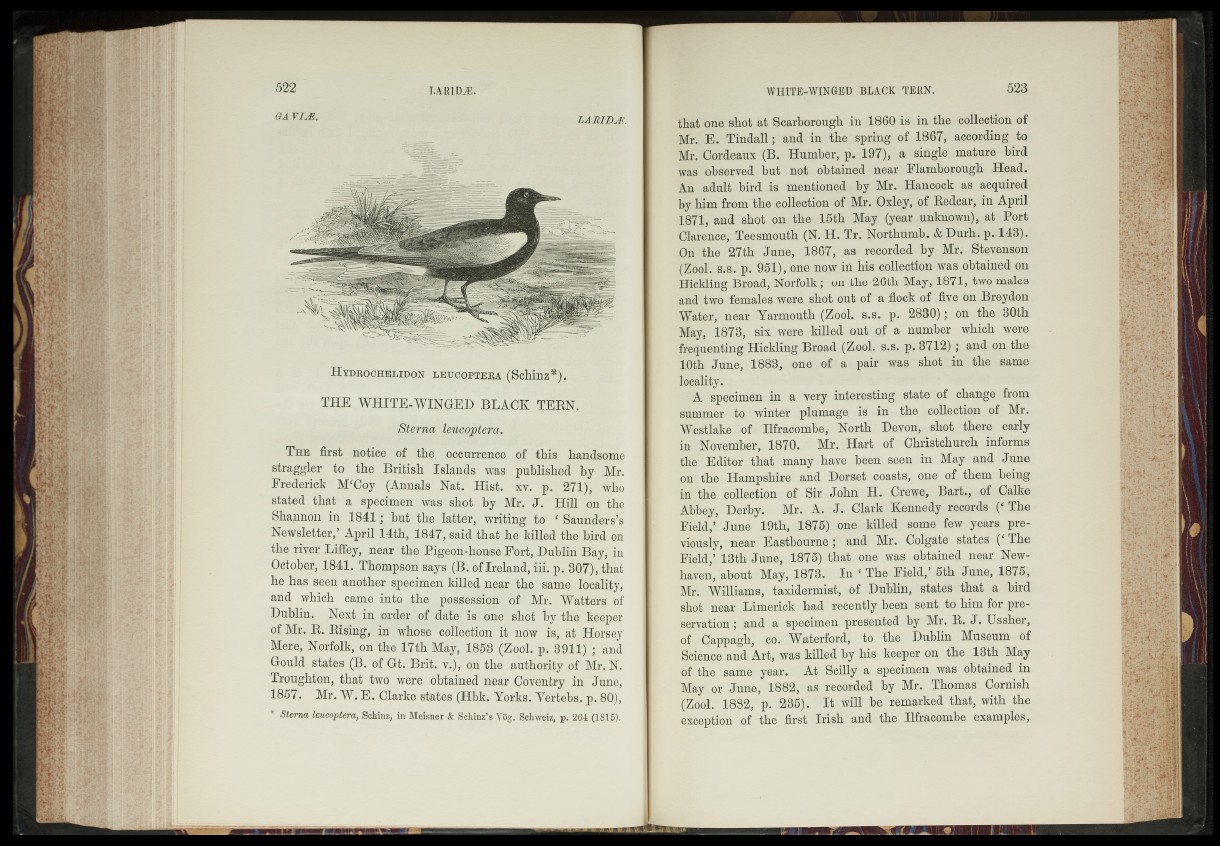
H y d ro c h e l id o n l e u c o p t e r a (Schinz*).
THE WHITE-WINGED BLACpI TERN.
Sterna, ~feugoptera.
T h e first notice of the occurrence of this handsome
straggler to the British Islands was published by^^Ir.
Frederick M‘Coy (Annals Nat. Hist. xv. p. 271),\who
stated that a specimen was shot by Mr. J. Hill op the
Shannon in 1841; but the latter, writing to e Saunders’s
Newsletter,’ April 14tl^JL847, said that he killed the bird on
the river Liffey, near |he Pigeonlhouse jB15rtfjDublin Bay, pi
October, 1841. Thompson says (Bi of Ireland, iii,jp. 307), that
he has seen another specimen felled near the same locality,
and which came into the. p/?/p|essfon o£ Mr. Watters %f
Dublin. : J |^ .t in order of date is/one shot by- the keeper
of Mr. R. Rising, in whose 'collection it now is, at ip llse y
Mere, Norfolk, on'the 17th May, 1853 (ftqol: p. 8911) j^and
Gould states (B. of Gt; Brit/ on the autEoritf of Mr. N.
Troughton,' that two were obtained near Coventry in .luiu1,
1857. Mr. W. E. Clarke states (Hbk. Yorks: Yertebs. p. 80),
* Sterna leucoptera, Schinz, ip Meisner & Senna's Yog. Schweiz, p. 264 (181^).
that one shot at Scarborough in 1860 is in the collection of
Mr. E. Tindall; and in the spring of 1867, according to
Mr. Gordeaux (B. Humber, p. 197),, a single mature bird
was .observed but not obtained near Flamborough Head.
An adult bird is mentioned by Mr. Hancock as acquired
by him from the collection of Mr. Oxley, of Redcar, in April
1871, and- shot/on the. 15th May (year unknown), at \Bort
Clarence, Teesmouth (N; H. Tr.' Northumb. & Durh. p. 143).
Oh the 27th June, 1867, as recorded by Mr. Stevenson
(Zoo!. s.s. p. 951), one now in, his collection was obtained on
Hickling Broad, Norfolk; on the 26th May, 1871, two males
and two females were shot out/of/a flock of five on Breydon
Water, near Yarmouth (Zool. s.s. p. 2830); on the 30th
May, 1873, six were -felled out of a number which were
frequenting Hickling BroadJ-Kool,, S.S. p. 3712); and on the
10th June, 1883," one of ‘ a pair was shot in the same
locality.
r A specimen in/ a very interesting state of- change from
summer to-'winter plumage is in the collection of Mr.-
Westlake -of Ilfracombe, -North/ Deyon, shot there early
in November, 1870.“ Mr. Hart of Christchurch informs;
the 'Editor that many have .been seen jjfc May and June
otf-tke Hampshire and- Dor set,/coasts, one of them being-
in the collection of Sir John H., Cxe^§,i. Bart., of Calke
Abbey, -Derby. Mr. A ., J. MmMi Kennedy records- (‘ The -
Eield,’ June 19th, 1875) one killed • some few years previously,
-near Eastbourne ; and Mr. Colgate states- p The
Field',’ 13th June,.-1875)‘that one was obtained near New/
haven, about May, 18.73. In ‘ The Field,’ 5th June, 1875,
Mr. Williams,' taxidermist, of Dublin, states that a bird
sftpfci near Limerick had recently been sent to him.Jjo? Pire-;
servation; and a specimen presented b y Mr. R. J. ITssher,r
of^Cappagh, -co.^ Waterford;./ to- the Dublin Museum of
Slience/ahd Art, was killed by his keeper on the '13th-May
of the same year;. At Scilly a specimen was obtained in
May/or June, 1882'--, as recorded by Mr. Thomas Cornish
(Zool. 1882, p. 2 3 5 )3 It will be remarked that, with the
exception of the first Irish and the Ilfracombe examples,